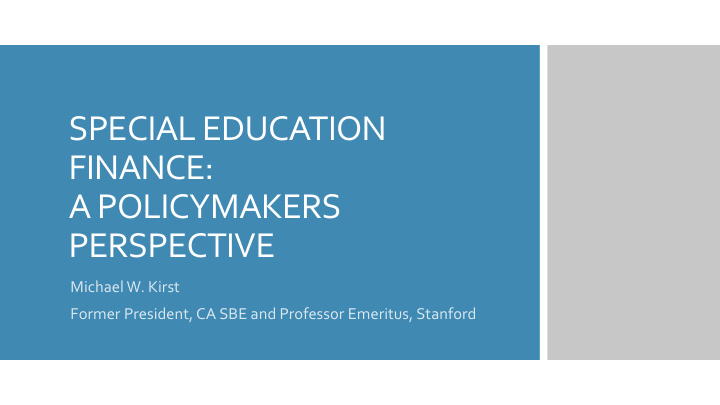



SPECIAL EDUCATION FINANCE: A POLICYMAKERS PERSPECTIVE Michael W. Kirst Former President, CA SBE and Professor Emeritus, Stanford
Expenditures increasing- up 20% in CA in last decade Majority mild disabilities like speech, but severe disabilities doubled in the last 20 years in CA Trends in Autism In CA increased from I in 600 students in 1998 to 1 in Special 50 in 2018 Federal Government promised 40% , but only pays 10% of Education total expenditures Finance Federal law with many constraints last renewed in 2004 Maintenance of effort encourages separate funding systems
High identification of minority and low-income students Special education students lag behind in student outcomes Trends in Significant recent increase in preschool student services Special Many agencies (mental health, vocational rehabilitation) Education help fund student services, but not sufficiently Parents and their lawyers clash with districts concerning Finance needed services, least restrictive settings, etc.
Finance is a means to end for better education services and outcomes Need to align state finance with best practice local education improvement and services into one coherent system Basic Special Very few school finance experts focus on special ed and school finance literature is separated between mainstream Education school finance and special ed Finance General and special ed often have different finance Problems distribution formulas and weights in many states Large finance weights for special ed students by disability can create incentives for excess identification of students An alternative is to use per pupil or per capita formulas, but they do not adjust for more expensive student needs, and may discourage more costly early intervention
Start with overall state policy goals and alignment and then move on to finance design- “all one system” Basic Special It is difficult to provide finance adjustments for small urban or rural districts with many students with severe disabilities Education Some states provide risk pools, fund these districts directly, Finance or utilize regional service providers Problems Other approaches to equity provide more money for low income, foster care, homeless pupils because disability is correlated with these conditions
Decide whether state finance objective is “adequate funding” or merely improving current financial support and effectiveness Choices and Is state formula a broken historical accretion that needs a major overhaul, or is the current funding approach in need Decisions For of repair? Improving What can states learn from each other-does state population size matter? Special Ed Process to involve parents, and other stakeholders in new Finance special ed finance system How to integrate special ed finance with state accountability (e.g., A-F ratings, dashboards) and state systems of support for local improvement under ESSA
Understand how the current finance system works from state to local level including for preschool, charters, virtual schools et Examine how finance system helps student transitions from preschool to elementary, and secondary school to postsecondary education Initial Steps In Decide how to adjust for low incidence high cost disabilities A Finance such as using weights, and districts/schools with high poverty concentrations Study Decide how much state needs to guide and modify local district control of services delivery (e.g., IEPs) Simulate amount each district gets from various options for state formulas and distribution system
Decide what the role (if any) regional entities should play in allocation of money and education support to local districts Initial Steps In Analyze your past use of state categorical set asides for such as: A Finance professional development, mental health, MTSS, employment training, etc. Study Consider how general education and special education relate to each other from your total state policy change
Recommend
More recommend